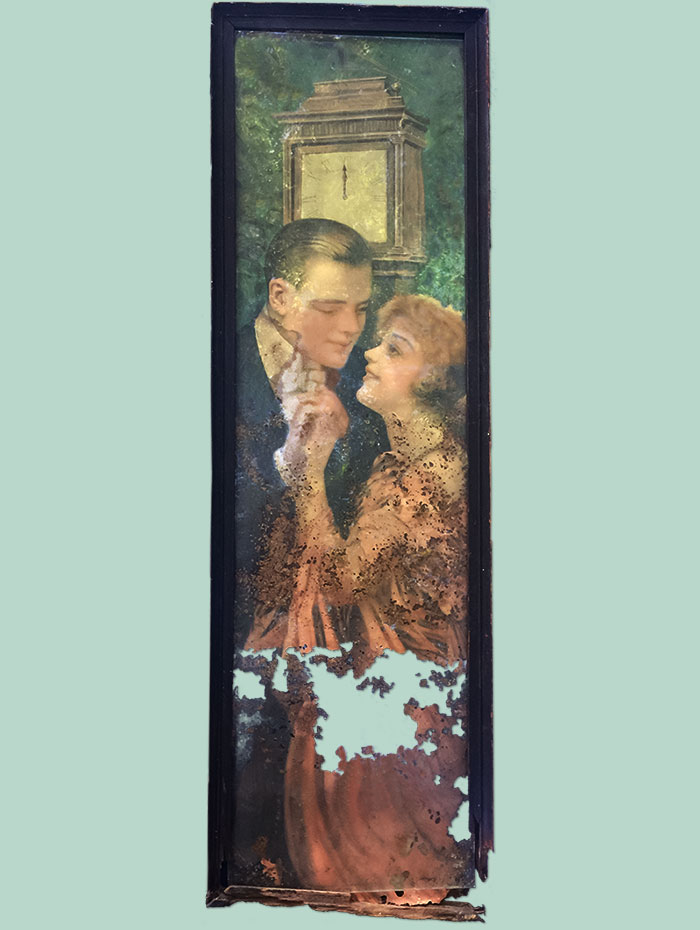
We're so sorry, honey, but an eye is a lens.
We're both sorry, you and me. Both of us, sweetheart.
Obviously, this eye is a lens. There is—a view. A view across the room. From one corner to another, a diagonal line that crosses the center of the space and goes out a door on the other side. The first room is called the room with a couch, because there is a couch in it. We're sitting on it. Outside of the door is a hallway, and then the door to another room. And then another—view. The diagonal line continues across the second room to another corner. In this second room a lamp is plainly, prominently visible, placed on the corner of a desk or low dresser; beyond the lamp, there is a large palm. It is about five feet high, with spreading leaves that are a deep green except at the very tips, where they have turned brown. Only half of this plant is visible. Beyond the palm, hanging on a wall near the corner, is a faded print in a black frame. The wall is white.
The print is very narrow, four inches across at most, and about two feet long. There are several features of this print that are obscured; one of the palm leaves cuts across the top of the frame and hides only the faces of two lovers, or dancers, who stand closely together as if in a slow waltz. Their two arms, raised in a dancing position, hands clasped. (the woman's hand almost completely within the hand of her partner), are prominent in the foreground just below the heads, or the space which is obviously occupied by heads. Above this invisible space is the face of a grandfather's clock, which is turned at a slight angle away from the surface plane of the print. If the print was the three-dimensional reality which it suggests—a narrow window with a view, perhaps, instead of a picture—the grandfather's clock would be turned precisely to face the room with a couch. This is a coincidence. The print is too stylized to be even briefly convincing as an actual view. The dramatic device of the clock hands both pointed at twelve ("when the two halves of Paris embrace") is inconsistent with the lighting, a diffused general glow which occurs in actuality just before dawn and after sunset—not at midnight. The scene is obviously placed at midnight, as the couple wears elegant dinner dress inappropriate at noon; also, there is a trace of darkness in the greenery which serves as vague background. But the grandfather's clock would never have been placed outside; perhaps it stands in front of a window, the edges of which are beyond the narrow confines of the print. Why would a clock be placed in front of a window?
There is something in the way these people are positioned that suggests music playing. Or a woman speaking from far away, perhaps crying, from the darkness in the greenery, or in the hallway between the rooms. It is barely heard.
Aging has begun to deteriorate the entire lower half of the print. Part of the lower frame edge has fallen completely away, and portions of the print are missing; the white wall is plainly visible here. Dark spots—areas where the brown backing paper appears—cover the bottom of her dress the true color. bottom of her dress, actually making it difficult to determine the true color. This process of decomposition becomes less severe near the clasped hands. The dress is pink. It is cut low across the shoulder, and the skin is very pale.
The fold of material draped across her arm goes all the way to the bottom of the frame. It obviously contrasts with the sleeve of the companion's tuxedo, which is difficult to distinguish (black material of the sleeve against the dark body of the coat). At the end, culminating in his large hand, a bit of the white cuff appears, and one side of a gold link. Then there are the hands, with the oppressive, suffocating gesture of domination. Or perhaps protection and tender care, love, courtship, a scenario including devotion and willing obedience. This is so evident, so glaring in the gown, the deep pink of the gown, pastel but severe and rich for a pink. The line in the folds is soft, diffuse, sfumato. Feminine.
Feminine.
That is why I was so surprised when the vision occurred which interposed; the apparition (almost) of a woman, or a shape which at first seemed a woman, walking quickly between the doorway of the room with a couch and the doorway of the room with a picture. Down the hall between them, then footsteps down the stairs. A few moments later, a car started and drove away. Clouds moved in the sky, the sun shone on the city, lives were lost in other places and a draft stirred the leaves of the palm. At least that half of the palm seen through the doorway. I could almost see her face, she was crying, there was a sigh or something, perhaps a hand raised to the eyes. How do you tell when a woman is crying? Do you offer her a handkerchief, or do you turn away?
I heard the car start and ran to the window, but I was too late.

